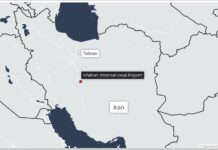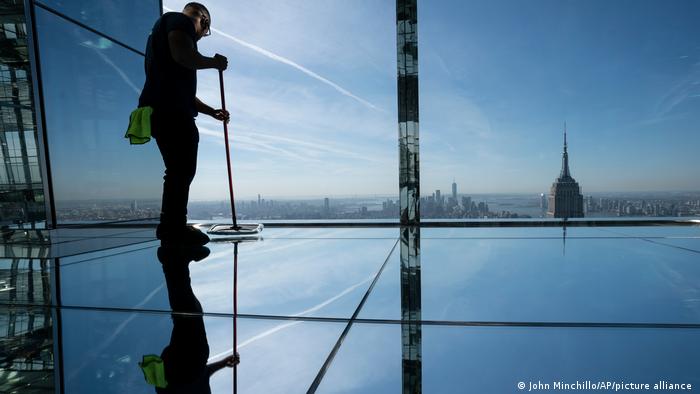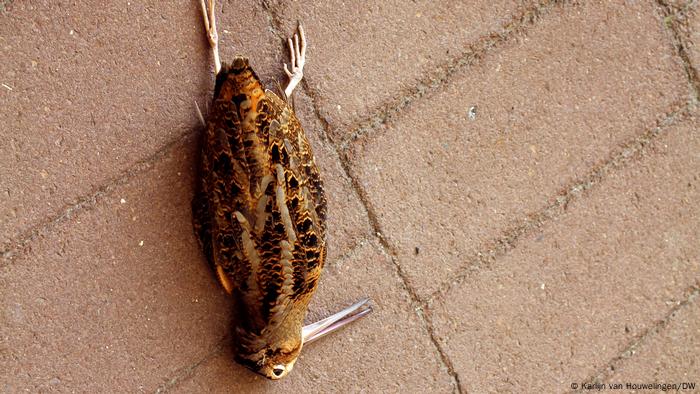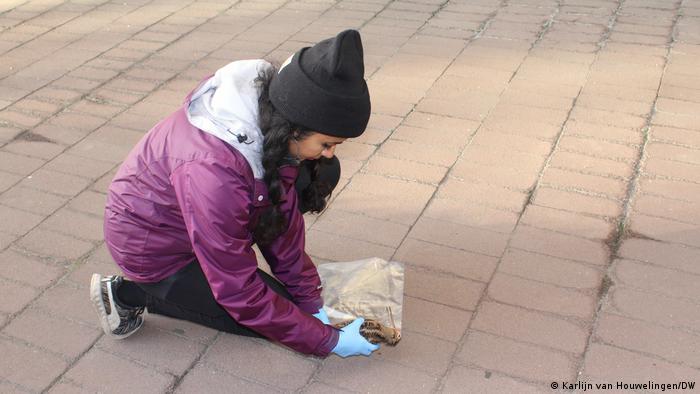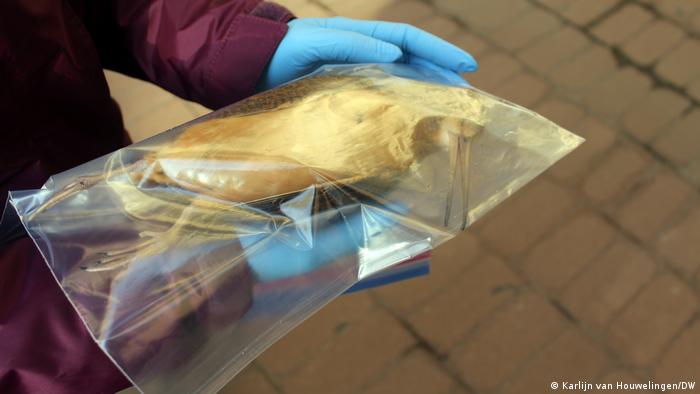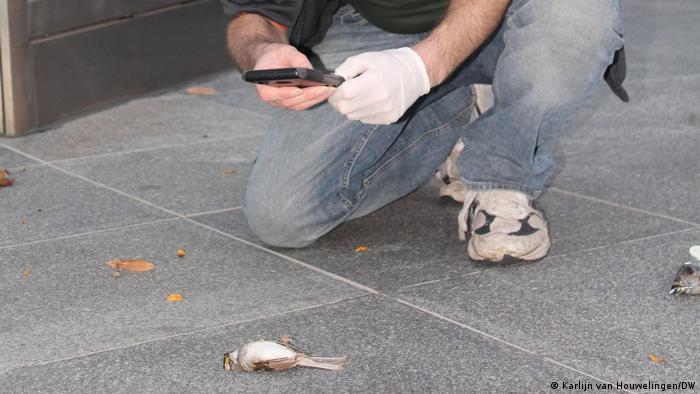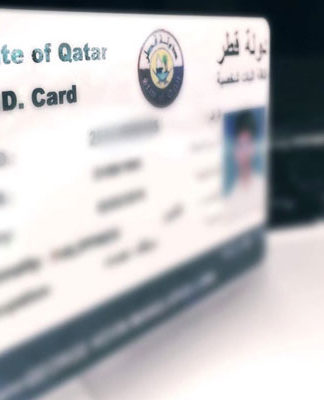Glass windows kill billions of birds a year. Scientists are working to change that
Conservationists are trying to convince governments and building owners around the world to introduce changes to stop birds from flying into reflective glass. Experts say the solutions are surprisingly simple.
Divya Anantharaman points her flashlight under the wooden benches surrounding an office tower near Wall Street. At this time, the streets of New York are still the exclusive domain of early risers. But starting her weekly search and rescue mission at this ungodly hour is essential, she says.
She’s looking for the victims of notorious bird killers: glass skyscrapers. When daylight breaks, doormen will sweep the sidewalks clean, and evidence of the dead will be lost.
Anantharaman volunteers for NYC Audubon, an urban conservation group that monitors bird deaths from window collisions. She inspects every dark corner on her route, looking through planters, careful not to miss a collision victim she could rescue. At the end of her round, she finds a dead bird beneath a gleaming glass overpass connecting two buildings.
It’s an American woodcock, she thinks, a relatively common migrating bird with a long beak. Every spring, woodcocks pass through New York after spending the cold months in Alabama and other Gulf coast states. This bird is stiff, which means it recently died, Anantharaman says. “The eyes are still so clear — this may have happened minutes ago.” She snaps photos, takes a solemn moment to close the eyelids with her thumb and puts the corpse into her pink backpack.
A billion birds and counting
Every year, 90,000 to 230,000 birds crash into New York buildings, NYC Audubon estimates. The city’s concentration of illuminated buildings is a dangerous obstacle for winged travelers, especially during the spring and fall migration seasons.
New York sits on a migration route to South America, where many birds spend the winter. Since birds navigate using stars, artificial nighttime light attracts and disorients them. Believing they are flying toward starlight, the birds detour and land in the middle of an unfamiliar metropolis.
“The biggest problem is reflective glass,” NYC Audubon biologist Kaitlyn Parkins says. “Birds don’t see a reflection of a tree. To them, it’s a tree. They fly at it, can accelerate very quickly and often die immediately.”
In the US, where most of the research into bird collisions has been done, buildings are responsible for the deaths of up to 1 billion birds every year, the pioneering ornithologist Daniel Klem calculated in the 1990s. But glass windows are deathtraps all over the world.
“Birds are vulnerable to glass wherever birds and glass are found together. They don’t see the bloody stuff,” Klem says. He adds that it’s not skyscrapers but rather low- and midrise buildings that pose the biggest threat.
Klem, now a professor at Muhlenberg College in Pennsylvania, considers window collisions a fundamental issue for the conservation of birds. “As a threat, I would put collision right after habitat destruction,” he says. “What’s so insidious is that windows kill indiscriminately. They also take the fittest in the population. We can’t afford to lose any individual, let alone good breeders.”
An international problem
In recent years, conservation groups and scientists have taken up the cause. Binbin Li leads one of two groups monitoring window strikes in China. She is an assistant professor of environmental sciences at Duke Kunshan University and earned a PhD at Duke in the US. There she met the leading researcher of the university’s bird collision project.
“First, I thought this was only a problem at Duke, or in the States — I could not imagine seeing it here in China,” she says. But, after her return, she got reports of three dead birds on campus within a month.
With a group of students, she now counts birds killed in flight on campus in Suzhou. Many of the victims, she notes, are found under glass corridors, just like the woodcock Anantharaman found in New York.
Li started a national survey to get a clearer picture of the problem. Three major migration pathways cut through China, but data on fatalities along these routes is still limited. “We realized that bird collision is not well-known in China, not even in academia,” Li says.
‘Just change the glass and turn off the lights’
In Costa Rica, Rose Marie Menacho had to convince her professors to let her investigate bird collisions as a PhD student eight years ago. “They didn’t know much about this subject, didn’t know it was a real problem,” she recalls. “Even I was a bit shy saying I was studying this. I was a little ashamed because I thought it was not so big.”
To understand the scale of the problem in the tropics, she now works with about 500 volunteers. Some store feathered corpses in their freezers, others send her reports and photos. “Not only migrating species collide,” she says. Her volunteers recovered vibrantly colored quetzals and toucans with flamboyant oversize beaks. Both are local species.
“Collision kills many birds who already have to deal with habitat loss, climate change, pesticides, et cetera,” says Parkins, the biologist. “And it’s so easy to solve — just change the glass and turn off the lights.”
With the data they gather, Parkins and her team are trying to convince the owners of glass buildings to act. Usually, they don’t need to replace any glass. Special foil can make it less reflective — and saves energy for heating and cooling. Markings on the windows can help birds see the structure. In one example, after a bird-friendly renovation of the Javits Convention Center, volunteers have found about 90% fewer dead birds around the building.
New York City adopted legislation in January to require public buildings to turn off lights at night during migration seasons. Since last year, architects must also use bird-friendly designs for all new buildings such as ultraviolet coating on glass, which is visible to birds but not to humans.
New regulations are a good start
On the sidewalk in front of Brookfield Place, an enormous office and shopping center on the southern tip of Manhattan, Rob Coover inspects a small bird. Daylight is still scarce, but he has already searched for dead birds for half an hour.
He checks carefully behind the piles of chairs the workers of a coffee shop will soon use on their terrace. Twice already he has bent over a tiny, stiff corpse to take photos. Now he again takes rubber gloves and plastic sandwich bags out of his backpack to pick up and preserve a body.
Coover once found 27 birds in a single morning. A fellow volunteer made international headlines when she picked up 226 lifeless birds around One World Trade Center in a single hour last September.
“It’s quite depressing, all these dead bodies,” Coover says. Sometimes he finds a survivor and takes the wounded animal to a bird sanctuary. Dead bodies usually go into his freezer until he has time to take them to the headquarters of the conservation group, where they are collected and some are distributed to museums. “Before the pandemic, I went to work after my rounds and put them in the office freezer.” No one ever noticed, he adds.
In the United States and Canada, volunteers are active in several communities, and the list of local governments enacting legislation to protect birds from buildings is growing. According to the nonprofit American Bird Conservancy, New York’s law is one of the most effective additions. After studying bird collisions for almost half a century Daniel Klem is delighted. He finally sees the growing awareness he has been hoping for.
“Climate change is also a very serious issue — nobody is interested in distracting from that. But it’s very complex, and it is going to take us a while to figure things out and convince people to do things responsibly,” he says. “Bird collisions, that’s something we could solve tomorrow. It’s not complex; we just have to have the will.”
Edited by: Ruby Russell





